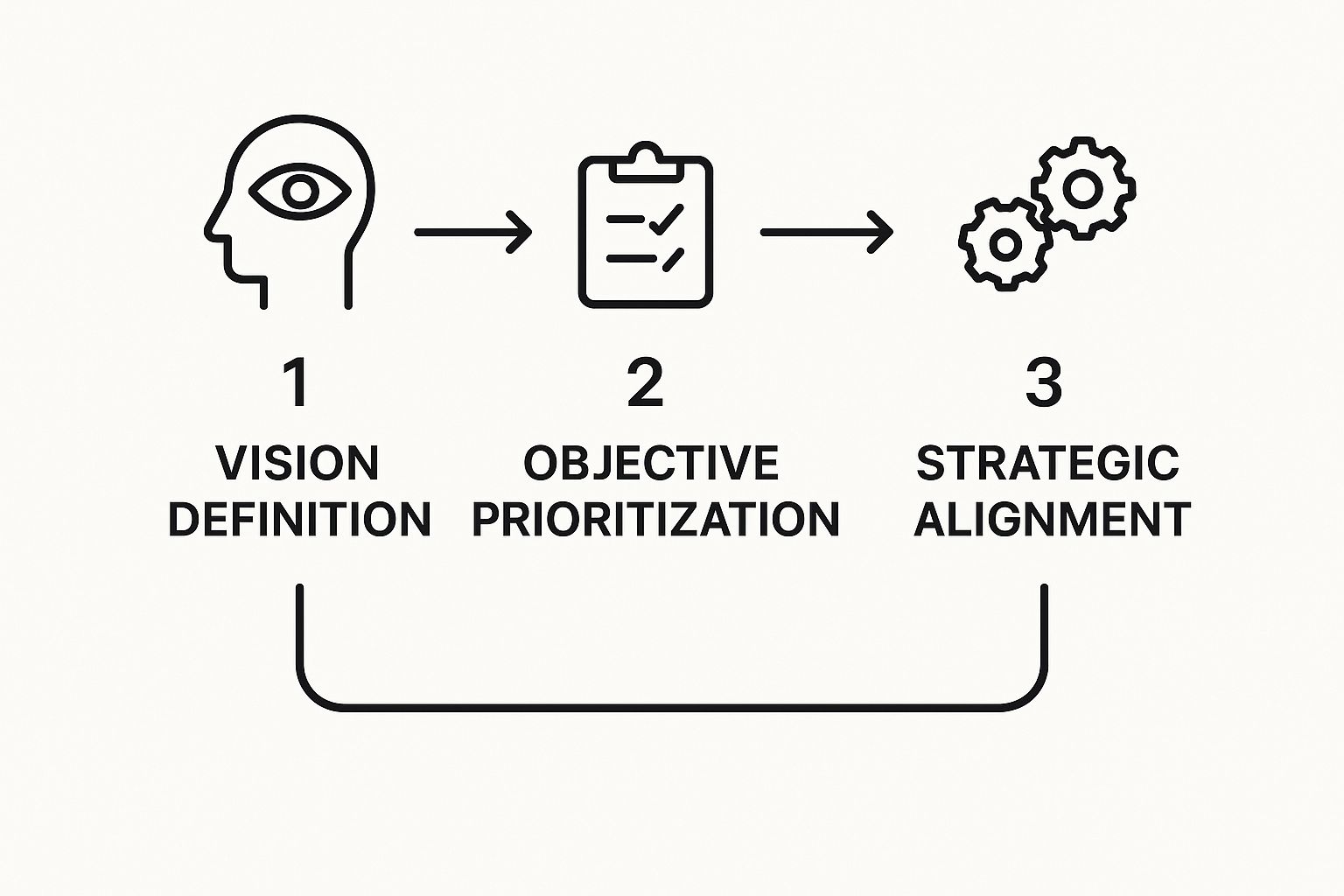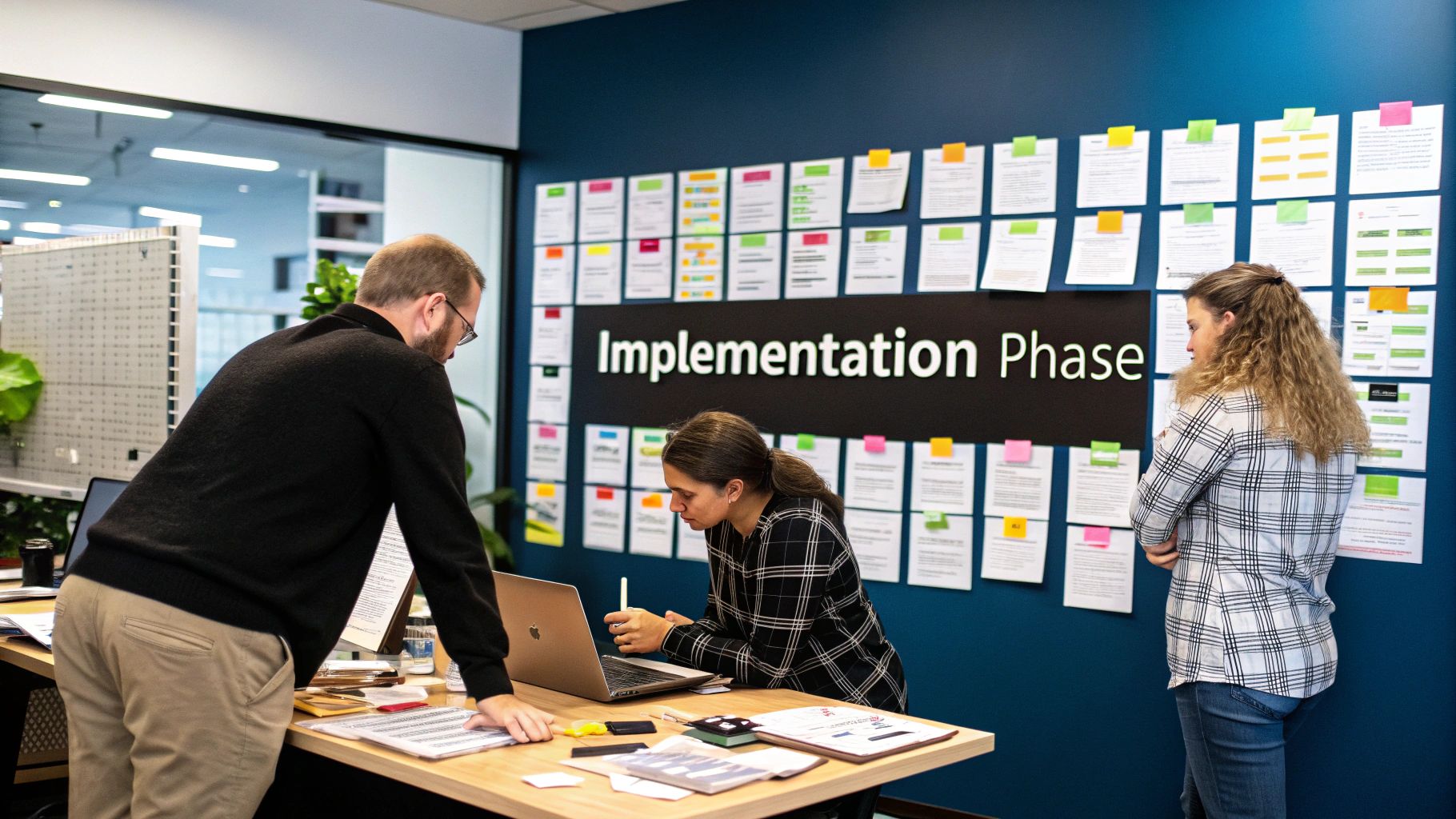A digital transformation roadmap isn’t just a shopping list for new tech; it’s your company’s strategic blueprint for weaving digital capabilities into the very fabric of your operations. Think of it as a detailed, phased plan for modernising how you work, delighting your customers, and hitting ambitious business goals.
Building Your Foundational Strategy

Before you even think about writing a single line of code or signing up for a new cloud service, the most important work happens. It’s a period of deep introspection. From my experience, the most successful digital roadmaps are built on a rock-solid strategic foundation, not just a vague desire to “go digital”. This first phase is all about asking the hard questions and getting crystal clear on what success actually looks like for your business.
This means you need to take an honest, unflinching look at where you stand right now. Go beyond the surface-level complaints and identify the real bottlenecks holding your teams back. Is your sales team burning hours on manual data entry? Is your supply chain crippled by a lack of real-time visibility? These are the kinds of concrete problems a well-planned digital initiative is meant to solve.
Define Clear Objectives and Secure Support
Vague ambitions like “improving efficiency” won’t get you very far. Your goals need to be sharp, measurable, and tied directly to tangible business outcomes.
For instance, instead of a fuzzy goal, aim for something like:
- Reduce customer support ticket resolution times by 25% within six months by rolling out an AI-powered chatbot.
- Increase supply chain forecast accuracy by 15% in the next fiscal year by integrating a new analytics platform.
- Improve team productivity by automating manual report generation, freeing up 20 hours per week for more strategic work.
When you frame your objectives this way, getting executive buy-in becomes much easier. You’re no longer just asking for a budget for new software; you’re presenting a compelling business case for measurable growth and improvement. This is the point where you need to build a coalition of the willing—a cross-functional team with champions from IT, marketing, operations, and even HR. These are the people who will advocate for the change and ensure the plan truly serves the entire organisation.
A common pitfall I see is companies treating digital transformation as just another IT project. It’s not. True transformation is a business-wide strategy that realigns your technology, processes, and people toward a shared vision. It needs to be championed from the C-suite and embraced by everyone on the ground.
Aligning with Market Realities
Understanding what’s happening outside your four walls is just as critical. The Indian digital transformation market, for example, is on an incredible growth trajectory, projected to leap from USD 26.7 billion to a staggering USD 126.8 billion by 2033. This explosion is being fuelled by companies embedding advanced tech like AI and robotics deep into their core functions.
This isn’t just an interesting statistic; it’s a signal of both urgency and opportunity for Indian businesses. Your foundational strategy must do more than just solve internal headaches—it needs to position your company to compete and win in this fast-changing environment. A key part of this is having a well-thought-out plan for adopting new technologies. For a deeper look at this, our guide on creating a comprehensive cloud adoption strategy is a great starting point. A solid plan ensures your roadmap becomes a powerful tool for market leadership, not just an internal to-do list.
Building Your Technology Foundation for Tomorrow

Now that you’ve got your strategic goals pinned down, it’s time to get your hands dirty and architect the technology that will bring your vision to life. This is the point where the digital transformation roadmap shifts from abstract ideas to concrete plans. We’re not just picking out some new software; we’re designing an entire ecosystem that can grow with you, stay secure, and adapt to whatever comes next.
The whole process really hinges on two modern IT cornerstones: cloud services and a DevOps mindset. Forget the buzzwords for a second. Think of them as a new way of working that gives your business the speed and flexibility it needs to stay ahead.
Picking the Right Cloud Flavour
The cloud isn’t a one-size-fits-all deal. The service model you choose will have a direct say in your budget, how much control you have, and what your team is responsible for day-to-day. It’s absolutely vital to get the mix right for your business.
- Infrastructure as a Service (IaaS): This model gives you the most control. You handle the operating systems and applications, while the cloud provider manages the physical hardware. It’s like leasing a piece of land where you can build exactly what you need perfect for businesses with unique compliance requirements or tricky legacy systems that need a specific environment.
- Platform as a Service (PaaS): Here, the provider takes care of the underlying infrastructure, freeing up your developers to do what they do best: build and run great applications. If you want to speed up development without getting bogged down in server management, PaaS is a fantastic choice.
- Software as a Service (SaaS): This is the simplest model. You subscribe to a finished application, like a CRM or accounting software, and use it over the internet. It has the lowest management burden and is brilliant for common business functions.
Many businesses I’ve worked with find a hybrid approach works best. For example, they might run a core, custom-built application on an IaaS platform for maximum control, but then use various SaaS tools for sales and marketing to keep things simple and predictable.
Expert Tip: Don’t let yourself get stuck in “analysis paralysis.” The smartest move is often to start small. Find a non-critical system or workload and try migrating it to a PaaS environment. This gives your team a tangible win and builds the momentum you’ll need for bigger, more complex projects later on.
A Solid Plan for Your Data
Your tech is only as valuable as the data running through it. A critical part of your roadmap is a well-thought-out, phased data migration plan. If you rush this, you’re asking for trouble think data loss, security holes, and serious disruption to your business.
The first step is always to classify your data. What’s absolutely mission-critical? What contains sensitive personal information? Answering these questions helps you set your migration priorities and the security measures needed for each data type.
From there, you need to establish clear data governance policies. This isn’t about creating red tape. It’s about being smart and deliberate about who can access what data, how it can be used, and who is accountable. This becomes even more important as you bring in technologies like AI, which depend entirely on high-quality, well-managed data to deliver anything useful.
Ultimately, your tech ecosystem should be your competitive edge. When you embrace a DevOps culture which is all about breaking down the walls between your development and operations teams you can automate processes and release new features much faster. Your technology stops being a cost centre and becomes the engine that drives your growth and keeps you secure.
Putting the Cloud to Work for Your Business
It’s easy to fall into the trap of treating cloud adoption as just another IT project, a simple box to tick. But that’s a real mistake. Think of the cloud as the engine that will power your entire digital transformation roadmap. It’s a strategic business decision, and when you get it right, it becomes the foundation for genuine agility, scalability, and far better customer experiences. This means going beyond a basic “lift-and-shift” of your servers and actively using cloud services to modernise how you operate from the ground up.
For businesses in India, the cloud isn’t just a nice-to-have; it’s a core component of growth and staying competitive. It’s a fundamental pillar of the national digital strategy, and projections show that cloud-native technologies will soon account for around 70% of the Indian digital market. This move is a huge part of the wider Digital India programme, which has already massively expanded service delivery through over 521,000 Common Services Centres (CSCs), giving millions of people access to digital services and bridging the urban-rural divide.
A Phased Approach to Cloud Migration
Trying to move everything to the cloud at once a ‘big bang’ migration is a recipe for disruption and unnecessary risk. A phased approach is almost always the smarter, more practical path.
Start small. Pinpoint a non-critical application or a specific business function that can act as a pilot project. For instance, a retail company might decide to move its internal inventory management system to the cloud first, long before touching its customer-facing e-commerce platform.
This way, your team gets its hands dirty, gains invaluable experience, and you can test your processes in a lower-stakes environment. Successfully migrating a single department’s workflow builds confidence across the organisation. It creates the momentum you need to tackle the more complex stages of your digital transformation roadmap. This is also the perfect time to explore the full spectrum of cloud migration benefits that go far beyond just saving a bit of money on hardware.
The goal of a phased migration isn’t just to move old applications to a new home. It’s an opportunity to modernise them. Ask yourself: can that monolithic legacy system be broken down into more agile microservices? Could you replace a clunky, on-premise database with a scalable, cloud-native alternative? Posing these questions is vital for getting the best possible return on your investment.
Choosing the right cloud service model is crucial for aligning your technology with business goals. This table compares the three main models to help you decide.
Cloud Adoption Models A Quick Comparison
| Service Model | What You Manage | Best For |
|---|---|---|
| IaaS (Infrastructure-as-a-Service) | Servers, storage, networking, OS | Maximum control for teams with strong IT expertise who want to build custom environments from scratch. |
| PaaS (Platform-as-a-Service) | Applications, data | Developers who want a ready-made environment to build, test, and deploy applications without managing underlying infrastructure. |
| SaaS (Software-as-a-Service) | Nothing it’s all managed by the vendor | Businesses looking for out-of-the-box software solutions (like CRM or email) with minimal IT overhead. |
Each model offers a different level of control and responsibility. Your choice whether IaaS, PaaS, or SaaS should directly reflect your team’s capabilities, your application needs, and your long-term business objectives.
Aligning Your Strategy for Maximum Impact
A successful cloud journey needs a clear, logical workflow. You need a way to connect your high-level vision to concrete, strategic actions. This is how you ensure every decision makes sense.

Following a flow like this from defining the vision to aligning the strategy guarantees that every cloud initiative directly supports a specific business goal. You can see this in action with platforms like DigiLocker in India, a perfect real-world example of using the cloud to enhance service delivery on a massive scale.
By focusing on security, scalability, and cost optimisation right from the start, your business can build similarly resilient and efficient solutions that your customers will truly appreciate.
Leading Your People Through Change
Let’s be honest: even the most sophisticated tech stack is useless if your teams refuse to use it. I’ve seen it happen. The human element is, without a doubt, the most critical piece of any digital transformation roadmap. Technology is just a tool. Your people are the ones who have to wield it to create real value, which is why a people-first plan for managing change isn’t optional it’s essential.
This goes way beyond a single company-wide email announcing the new direction. You need a continuous communication strategy that keeps everyone in the loop, engaged, and genuinely optimistic about where you’re headed. The real goal isn’t just to manage resistance; it’s to build a team of true advocates for the new way of working.
This mirrors what we’re seeing across India. The government’s Digital India initiative is fundamentally about empowering the population with digital literacy, not just rolling out new systems. With the country’s digital GDP projected to reach US$1 trillion, it’s a massive proof point that getting people on board is what makes technological change stick. You can get a deeper look into India’s digital evolution on india-briefing.com.
Closing Skill Gaps and Fostering Collaboration
One of the biggest anxieties I hear from employees is the fear that new tech will make their jobs redundant. The best way to tackle this head-on is to identify skill gaps early and roll out specific training programmes. It sends a clear message: we’re investing in your future with us, not looking to replace you.
Think about it this way: if you’re automating the painful process of manual reporting, you can offer training in data analysis tools. Suddenly, the employees who spent hours just compiling data are now capable of interpreting it. They’ve shifted from a manual task to a strategic one, adding far more value.
A crucial step is creating genuinely open channels for feedback. When people feel heard and see their suggestions taken seriously, they stop being passive recipients of change and become active partners in the journey. That sense of ownership is priceless.
This is also your golden opportunity to finally break down those departmental silos. When you put people from IT, marketing, and operations on the same transformation project, they start to understand each other’s worlds. This cross-functional teamwork is central to modern IT. In fact, it’s a non-negotiable part of any serious DevOps implementation roadmap, where tearing down these walls is fundamental to delivering value faster.
Cultivating a Culture of Change
For any of this to last, these new behaviours must become part of your company’s DNA. This means actively recognising and rewarding actions that support the transformation, like collaboration, smart experimentation, and a commitment to learning.
Here are a few ways to get the ball rolling:
- Launch Pilot Programmes: Start with small, cross-functional teams. Their success stories will become powerful internal case studies that get everyone else excited.
- Appoint Change Champions: Find those influential, respected employees in various departments and make them your ambassadors. They can offer peer support and translate the big-picture vision into what it means for their colleagues day-to-day.
- Communicate the ‘Why’ Relentlessly: Never stop talking about the reasons behind the change. Connect the dots for people, showing them how this will not only strengthen the company but also make their own roles more meaningful and impactful.
By putting your people at the heart of the strategy, you transform what could be a disruptive and difficult process into a shared journey of growth.
Measuring Progress and Driving Continuous Innovation

It’s a classic mistake I see all the time: treating your digital transformation roadmap like a project with a fixed end date. Once everything is implemented, the work is done, right? Not quite. In my experience, the real work and the real value begins right there.
The goal is to build a rhythm of continuous improvement. This is where you measure what’s working, learn from what isn’t, and adapt. This final phase isn’t about ticking off boxes; it’s about embedding a data-driven culture that keeps your organisation sharp and ahead of the curve long after the initial launch buzz has faded.
Your focus needs to shift from simply tracking project milestones to measuring genuine business impact. Sure, the IT team cares about server uptime, and they should. But those metrics don’t resonate in the boardroom. Your executives want to know how this massive investment is actually improving the business.
Defining Meaningful Key Performance Indicators
To prove the value of your work, you need the right Key Performance Indicators (KPIs). These aren’t just random metrics; they should link directly back to the strategic goals you set out at the very beginning. If your goals were vague, your results will be too. Specific KPIs, on the other hand, drive focused, intentional action.
So, instead of just reporting that a new system is live, you should be tracking business-centric outcomes.
Here’s what that looks like in the real world:
- Customer Impact: Are customers happier? Look at your Customer Satisfaction (CSAT) scores or Net Promoter Score (NPS). Is customer churn decreasing? For an e-commerce client, we once tracked a steady rise in average order value as a direct result of a new personalisation engine. That’s a win.
- Operational Efficiency: Are things moving faster? Measure the order-to-cash cycle time or how long it takes to bring a new product to market. We celebrated a 15% reduction in manual data entry errors at one company a concrete efficiency gain that freed up dozens of hours a week.
- Employee Productivity: Are your teams actually using the new tools? High adoption rates are a great sign. Another powerful metric is a decrease in the time employees spend on mundane, repetitive work. It shows the transformation is making their jobs better, not just different.
When you focus on these kinds of KPIs, you’re not just reporting data; you’re telling a story about the return on investment (ROI). This is how you keep executive buy-in and secure funding for what comes next.
The most effective transformations establish agile feedback loops. This means regularly collecting data, reviewing it with stakeholders, and using those insights to make quick, informed decisions. It’s about being responsive, not just following a rigid, outdated plan.
Establishing Lean Governance and Iteration
Governance is critical for keeping your transformation on track, but it absolutely cannot become a bureaucratic monster that kills innovation. What you’re aiming for is lean governance a lightweight framework that provides just enough oversight to guide the process without slowing everyone down. This usually involves regular, structured check-ins where key stakeholders review progress against your KPIs.
This iterative rhythm is what allows your organisation to pivot when needed. Maybe a pilot project shows that a new technology isn’t delivering the goods, or customer feedback uncovers a brilliant opportunity you hadn’t even considered.
This agile approach gives you the power to:
- Refine Processes: Use data to spot the real bottlenecks in your new workflows and then fix them. It’s about constant tweaking.
- Adjust Priorities: The market will change. A new technology will emerge. This approach lets you adjust your roadmap’s priorities without throwing the whole thing out.
- Uncover New Opportunities: This is my favourite part. When you start analysing performance data, you often find unexpected insights that can spark ideas for new services, products, or efficiencies you never would have found otherwise.
This cycle measure, learn, iterate is what transforms your roadmap from a static document into a living, breathing strategy. It’s what ensures you’re not just modernising for today, but building an organisation that can adapt and thrive for years to come.
Common Questions About Digital Transformation
Diving into a digital transformation often feels like opening a Pandora’s box of questions, especially at the beginning. I’ve sat in countless boardrooms across India where leaders are wrestling with the same core challenges: How long will this take? Who should be on the team? How do we get everyone on board?
Getting solid, experience-backed answers to these questions is the first step toward building a digital transformation roadmap that actually works. Let’s tackle some of the most frequent queries I hear.
How Long Does a Roadmap Take to Build?
There’s no single timeline, and anyone who gives you one without knowing your business is guessing. The real answer depends entirely on your company’s scale, the complexity of what you do, and just how big your transformation goals are.
A mid-sized company with a very specific goal say, migrating a key application to the cloud and adopting CI/CD pipelines might map this out in 6-8 weeks. On the other hand, a large, established enterprise aiming for a complete operational overhaul could easily spend 4-6 months doing the deep discovery, stakeholder alignment, and strategic work needed before a single line of code is written.
My advice? Don’t rush the foundation. A roadmap thrown together quickly will only lead to costly delays and rework later. Spending an extra month on planning is a far better investment than trying to fix a broken strategy mid-flight.
What Is the Biggest Roadblock to Transformation?
It’s rarely the technology. While a tricky cloud migration or a complex software integration can cause headaches, the single biggest hurdle I see, time and time again, is cultural resistance.
People are creatures of habit. They’re comfortable with the tools and processes they’ve used for years. The announcement of new technology often brings fear fear of becoming irrelevant, fear of not being able to learn the new system, or fear that their job will become harder.
Your transformation’s success hinges almost entirely on how well you manage this human element. This isn’t just about sending a company-wide email. It requires a dedicated change management plan focused on:
- Communicating the ‘why’ relentlessly. Everyone needs to understand the vision behind the change.
- Investing in upskilling. Offer targeted training that gives people the confidence and skills to thrive.
- Showcasing personal wins. Highlight how the new tools make an individual’s job easier or more impactful, not just how they benefit the company’s bottom line.
When you tackle the people problem first, you stop fighting an uphill battle and start building a groundswell of support.
Should We Hire Consultants for Our Roadmap?
This really comes down to your team’s bandwidth and existing expertise. If your internal teams are already running at full capacity or if you’re missing deep knowledge in critical areas like cloud architecture, DevOps practices, or organisational change, then bringing in consultants can be a game-changer. They offer an unbiased perspective and a wealth of experience from other projects, which can dramatically accelerate your progress.
But here’s the crucial part: it has to be a partnership. Consultants should never build your roadmap for you in isolation. The most successful engagements are collaborative, where they work hand-in-glove with your own people. This ensures the plan is grounded in your reality and, more importantly, that the knowledge gets transferred to your team so they can own and execute it long after the consultants have left.
At Signiance Technologies, we don’t just hand you a plan; we partner with you to navigate these very complexities. We help build the robust cloud and DevOps strategies that become the engine for true digital transformation. Discover how our expertise can help you build and execute a roadmap that delivers real results.
